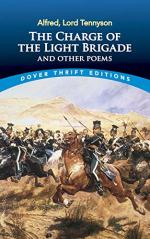|
This section contains 336 words (approx. 1 page at 400 words per page) |

|
The Charge of the Light Brigade Summary & Study Guide Description
The Charge of the Light Brigade Summary & Study Guide includes comprehensive information and analysis to help you understand the book. This study guide contains the following sections:
This detailed literature summary also contains Bibliography on The Charge of the Light Brigade by .
Tennyson wrote "The Charge of the Light Brigade" in a few minutes on December 2, 1854, after reading an article in the London Times about the Battle of Balaclava in the Crimean War, which was fought from 1853 to 1856 between Russia on one side and England, France, Turkey, and Sardinia on the other. According to his son, Hallam Tennyson, it was the poet's method to catch phrases that attracted his interest, which he "rolled about, so to speak, in his head, before he wrote them down." In this case, the phrase from the newspaper article was "some hideous blunder," which appears in the poem as "someone had blundered": this might indicate that Tennyson was seeking to blame someone for the disastrous massacre that wiped out the Light Brigade, but the "someone" is never mentioned again. This poem is about courage, not about the bad luck or stupidity that put the men of the Light Brigade cavalry in a position to display that courage.
The Charge of the Light Brigade" was first published in the December 9, 1854, issue of the London Examiner and was later included in Tennyson's collection Maud, and Other Poems in 1855. In 1850, Tennyson was appointed by Queen Victoria to succeed Wordsworth as poet laureate of England. Although Victoria's reign is associated with the Enlightenment, a time when logic and reason were the celebrated ideals, this poem celebrates the native dignity of the uneducated cavalrymen, of whom Tennyson says, "Theirs was not to reason why." Perhaps because it celebrates the common man at a time of social change that generally favored the intellectual, the poem was tremendously popular in its day, although generations that followed have remembered it, usually negatively, as a celebration of war's glory. In Tennyson's time, though, the poem had such all-around popularity that the poet was induced years later to return to the same battle, in a poem examining a much more successful assault by the British troops: "The Charge of the Heavy Brigade at Balaclava," published in 1885's Tiresias and Other Poems.
Read more from the Study Guide
|
This section contains 336 words (approx. 1 page at 400 words per page) |

|



